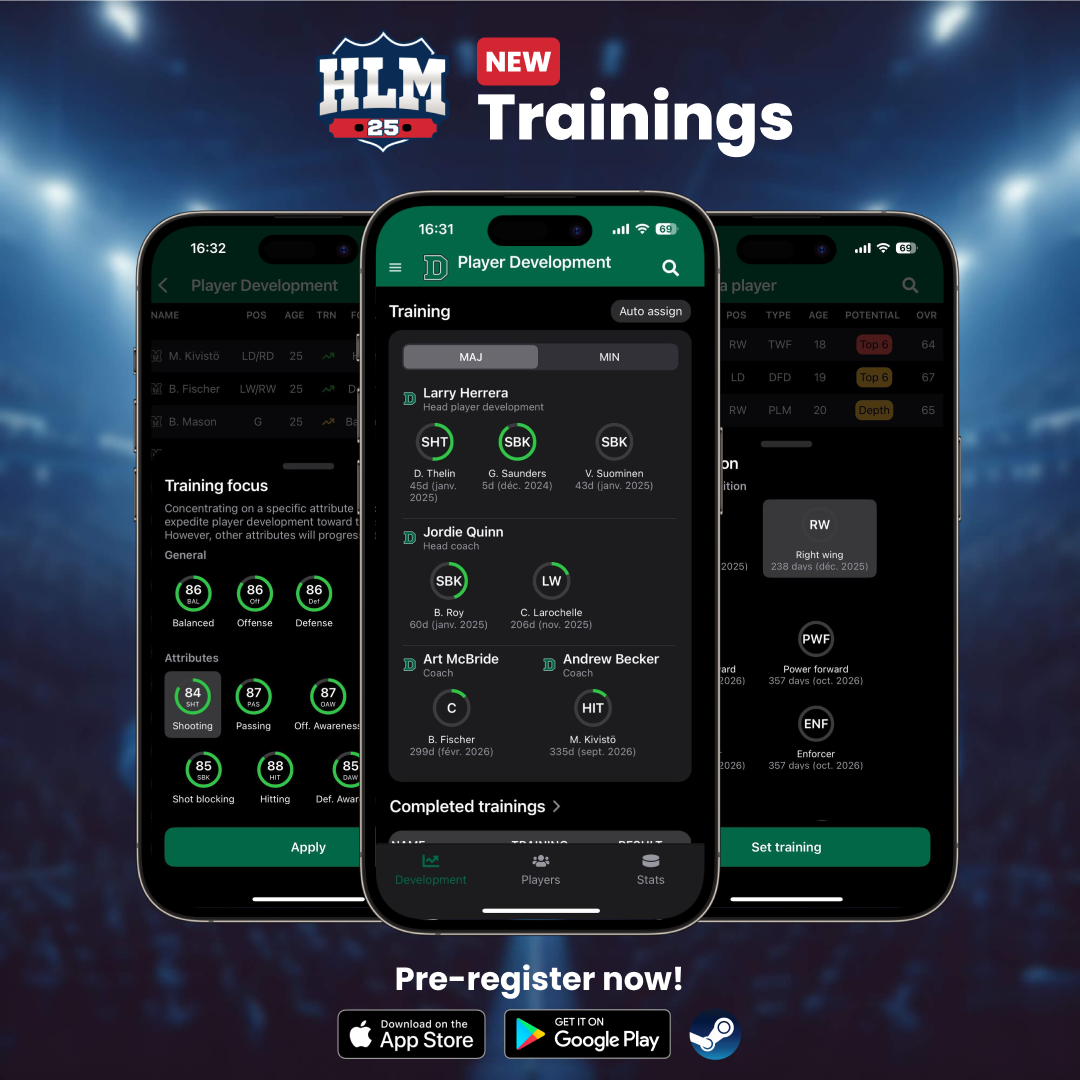

HLM25 will give you more control over your player development! Introducing trainings, development focus and development trends!
Trainings
The staff of a team can train players to help them improve more quickly in specific aspects of their game. Here are the roles that can train players:
| Role | Training slots |
| Head of Player Development | 3 |
| Head Coach | 2 |
| Assistant Coach | 1 |
The Head of Player Development can train any players within the organization. Other roles can only train players in their respective leagues.
Here are the available types of training:
- Secondary Position: This training allows a player to add a secondary position.
- Player Type: This training allows a player to change their player type.
- Ratings: This training improves one of a player’s attributes by 1 (+1). These training options are only available for players who do not have an exact motivation.
A player’s training can be paused; however, progress will be lost if the player starts another training program.
Training is only available during the season and preseason.
The duration of training is calculated based on several factors:
- Player’s Age: The younger the player, the faster the training.
- Player’s Potential: The higher the potential, the faster the training.
- Difference Between Current Overall and Potential Overall: The greater the difference, the faster the training.
- Attribute Value: Training for a player with a shooting attribute of 90 will take much longer than for an attribute of 60.
- Number of Completed Trainings: The more training sessions completed, the slower the progress.
- Coach’s Attributes: These also affect the training duration.
Here’s an example of training duration for an 18-year-old defenseman with High Top 4 potential and an overall rating of 70:
- Secondary Position: 178 days (6 months).
- Player Type: 267 days (9 months).
- Rating: Between 110 and 135 days (4 months).
Development Focus
The development focus allows you to determine which aspect of their game a player should concentrate on. When a player focuses on a particular aspect, other areas of their game will improve more slowly than usual. There are several types of focus:
- Balanced: All of the player’s attributes will be improved equally.
- Offense: Offensive attributes will be prioritized, so the player’s defensive game will develop more slowly.
- Defense: Defensive attributes will be prioritized, so the player’s offensive game will develop more slowly.
- Shooting: The player focuses on improving their Shooting attribute, with other attributes developing more slowly.
- Passing: The player focuses on improving their Passing attribute, with other attributes developing more slowly.
- Offensive Awareness: The player focuses on improving their Offensive Awareness attribute, with other attributes developing more slowly.
- Defensive Awareness: The player focuses on improving their Defensive Awareness attribute, with other attributes developing more slowly.
- Shot Blocking: The player focuses on improving their Shot Blocking attribute, with other attributes developing more slowly.
Development Trend
The development trend indicates how optimal the development environment is for a player. This trend affects the speed at which a player develops. Here’s an example for each level:
| Icon | Trend | Result |
| Outstanding | The player will improve much faster than expected this season. | |
| Excelling | The player will improve faster than expected this season. | |
| Normal | The player will improve as expected this season. | |
| Slow | The player will improve less than expected this season. The impact on their long-term development will be minimal. | |
| Very slow | The player will improve much less than expected this season. The impact on their long-term development will be noticeable. | |
| None | The player will not improve this season. The impact on their long-term development will be significant. |
The development environment is influenced by several factors:
- Quality of Competition: The caliber of the league in which the player competes. If a player is in a league that is too strong or too weak for them, it will negatively impact their development trend.
- Number of Games Played: If a player spends half the season on the bench, it will negatively impact their development trend.
- Number of Playoff Games Played: The more playoff games a player participates in, the more positively it affects their development trend.
- Number of Games Missed Due to Injury.
- Player’s Production.
Therefore, it is important to place young players in appropriate leagues to optimize their development.

Other development changes
- Potential drops will happen much later in player development and less frequently.
- Added an individual rating increase (+1, -1) next to the rating on the player profile.
- Goalies will develop until 28 years old (compared to 26 for skaters)
I love your game- have bought it since I knew about it in 2021.
Your improvements are great- but would love an option to simplify GM mode to turn off scouting (vague central scouting only) and staff hires(no bonuses for type of coaches is the downfall but simpler) and no training (normal development)
For people like me who prefer the simpler games of what if with the NHL, if a game requires too much behind the scenes I tend to lose interest from too much involvement being required.
I really enjoy just running the sim on my built roster and team:)
Great game! Wish you all the wealth in the world.
Hello! You can’t turn off scouting, but you can turn off staff hires and trainings!
I’m most excited for this feature! This years game already looks amazing and I can’t wait for release!